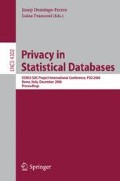Abstract
Controlled tabular adjustment preserves confidentiality and tabular structure. Quality-preserving controlled tabular adjustment in addition preserves parameters of the distribution of the original (unadjusted) data. Both methods are based on mathematical programming. We introduce a method for preserving the original distribution itself, a fortiori the distributional parameters. The accuracy of the approximation is measured by minimum discrimination information. MDI is computed using an optimal statistical algorithm—iterative proportional fitting.
Access this chapter
Tax calculation will be finalised at checkout
Purchases are for personal use only
Preview
Unable to display preview. Download preview PDF.
References
Cox, L.H.: Linear sensitivity measures in statistical disclosure control. Journal of Statistical Planning and Inference 5, 153–164 (1981)
Cox, L.H., Ernst, L.: Controlled rounding. INFOR 20, 423–432 (1982)
Cox, L.H., Fagan, J., Greenberg, B., Hemmig, R.: Research at the Census Bureau into disclosure avoidance techniques for tabular data. In: Proceedings of the Survey Research Methods Section, American Statistical Association, Alexandria, VA, pp. 388–393 (1986)
Cox, L.H.: Suppression methodology and statistical disclosure control. Journal of the American Statistical Association 75, 377–385 (1980)
Cox, L.H.: Network models for complementary cell suppression. Journal of the American Statistical Association 90, 1153–1162 (1995)
Fischetti, M., Salazar-Gonzalez, J.J.: Models and algorithms for optimizing cell suppression in tabular data with linear constraints. Journal of the American Statistical Association 95, 916–928 (2000)
Cox, L.H., Dandekar, R.A.: A new disclosure limitation method for tabular data that preserves data accuracy and ease of use. In: Proceedings of the 2002 FCSM Statistical Policy Seminar. U.S. Office of Management and Budget, Washington, pp. 15–30 (2004)
Cox, L.H., Kelly, J.P., Patil, R.: Balancing quality and confidentiality for multivariate tabular data. In: Domingo-Ferrer, J., Torra, V. (eds.) PSD 2004. LNCS, vol. 3050, pp. 87–98. Springer, Heidelberg (2004)
Kullback, S., Leibler, R.A.: On information and efficiency. Annals of Mathematical Statistics 86, 79–86 (1951)
Hodges Jr., J.L.: The significance probability of the Smirnov two-sample test. Arkiv for Matematik 3, 469–486 (1957)
Schmid, F., Trede, M.: A distribution free test for the two sample problem for general alternatives. Computational Statistics and Data Analysis 20, 409–419 (1994)
Shroer, G., Trenkler, D.: Exact and randomization distributions of Kolmogorov- Smirnov tests two or three samples. Computational Statistics and Data Analysis 20, 185–202 (1995)
Buning, H.: Robustness and power of modified Lepage, Kolmogorov-Smirnov and Cramer-Von Mises two sample tests. Journal of Applied Statistics 29, 907–924 (2002)
Pederson, S.P., Johnson, M.E.: Estimating model discrepancy. Technometrics 32, 305–314 (1990)
McLaren, C.E., Legler, J.M., Brittenahm, G.M.: The generalized Chi-square goodness-of-fit test. The Statistician 43, 247–258 (1994)
Author information
Authors and Affiliations
Editor information
Editors and Affiliations
Rights and permissions
Copyright information
© 2006 Springer-Verlag Berlin Heidelberg
About this paper
Cite this paper
Cox, L.H., Orelien, J.G., Shah, B.V. (2006). A Method for Preserving Statistical Distributions Subject to Controlled Tabular Adjustment. In: Domingo-Ferrer, J., Franconi, L. (eds) Privacy in Statistical Databases. PSD 2006. Lecture Notes in Computer Science, vol 4302. Springer, Berlin, Heidelberg. https://doi.org/10.1007/11930242_1
Download citation
DOI: https://doi.org/10.1007/11930242_1
Publisher Name: Springer, Berlin, Heidelberg
Print ISBN: 978-3-540-49330-3
Online ISBN: 978-3-540-49332-7
eBook Packages: Computer ScienceComputer Science (R0)

